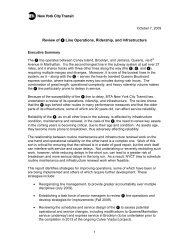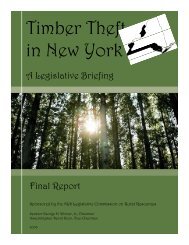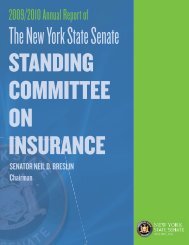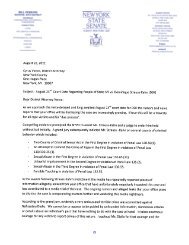Crime Committee Report e.indd - New York State Senate
Crime Committee Report e.indd - New York State Senate
Crime Committee Report e.indd - New York State Senate
You also want an ePaper? Increase the reach of your titles
YUMPU automatically turns print PDFs into web optimized ePapers that Google loves.
Chapter 271 of the Laws of 2009<br />
S.3401 HASSELL-THOMPSON, ADAMS, DIAZ, KRUEGER /A 7565 Aubry<br />
E-Justice<br />
Signed into law by Governor Paterson, this legislation permits sheriffs and local commissioners<br />
of correction to expand the use of new identification technology in their county jails. Beginning<br />
in 2010, the Division of Criminal Justice Services, as part of the “E-Justice Program”, will<br />
no longer accept traditional inked fingerprints cards for processing. Instead, all fingerprints<br />
will have to be submitted electronically through a system known as “Live Scan”. Prior to the<br />
new law, there were serious legal questions as to whether county jail “Live Scan Units” could be<br />
used to electronically print people who had not been arraigned on criminal charges. The new<br />
law permits the Sheriff to bring civilians into county jail for fingerprints connected to pistol<br />
permits, licenses or other needs unrelated to criminal charges. The new law saved counties the<br />
expense of unnecessarily purchasing new Live Scan units and made it convenient for civilians<br />
and sheriffs to expedite security checks and job applications. The new law would also permit<br />
the local jails to electronically print arrestees prior to arraignment in a criminal or district<br />
court. This amendment will expedite the process of making arrestees “court ready”, and save<br />
tax payers the cost of unnecessarily purchasing and administering duplicitous services. This<br />
legislation passed both houses unanimously.<br />
Chapter 272 of the Laws of 2009<br />
S.3402 HASSELL-THOMPSON, KRUEGER / A 8060 Markey<br />
<strong>Crime</strong> Victims Awards for Children<br />
Signed into law by Governor Paterson, this legislation permits certain kinds of awards that<br />
could be made to child victims in the absence of physical injuries. In particular, awards could<br />
be made for certain personal property damage, expenses of transportation to court, and counseling<br />
expenses. Prior to this legislation, the law required that a physical injury be sustained by<br />
a victim in order for a crime victim’s award to be made. There were a few explicit exceptions<br />
for elderly victims, disabled victims, kidnapping victims and stalking victims. This law extended<br />
the exception to children who may be witnesses to crimes or crime victims which did not result<br />
in physical injury – but did result in property damage of emotional trauma. This legislation<br />
passed both houses unanimously.<br />
S.2490-E<br />
Chapter 278 of the Laws of 2010<br />
KLEIN, ADAMS, DIAZ, HASSELL-THOMPSON, C. JOHNSON, KRUEGER, MAZIARZ,<br />
ONORATO, PARKER, SAMPSON, SAVINO, THOMPSON / A 3024-F Benjamin<br />
Provides notice to municipal housing authorities whenever a sex offender is released to<br />
public housing<br />
Signed into law by Governor Paterson<br />
In 1998, Congress banned subsidized housing for the most serious sex offenders after a<br />
convicted sex offender was charged with assaulting and molesting a 9-year-old neighbor girl<br />
who lived in the same public housing building. Also known as the Quality Housing and Work<br />
Responsibility Act, this new legislation prohibited housing authorities from admitting any<br />
household that includes a person subject to the lifetime sex offender registration requirement.<br />
In March 2009, a report released by NYC Councilman Eric Gioia found 126 sex offenders<br />
living in <strong>New</strong> <strong>York</strong> city public housing facilities, up 12% from the. year before. 42 of the City’s<br />
3,432 registered sex offenders live in projects in Brooklyn, 37 in Manhattan, 26 in the Bronx, 8<br />
in Queens and 3 in <strong>State</strong>n Island.<br />
More recently, a report by the Inspector General of the Housing and Urban Development<br />
(HUD) Department, estimated that roughly 2,100-3,000 households currently residing in federally<br />
subsidized housing include a serious sex offender. According to investigators, the primary<br />
Standing <strong>Committee</strong> on <strong>Crime</strong> Victims, <strong>Crime</strong> and Correction | 2009-2010 <strong>Report</strong> 47









![[PDF] Proposed MTA Capital Program - New York State Senate](https://img.yumpu.com/24854139/1/190x245/pdf-proposed-mta-capital-program-new-york-state-senate.jpg?quality=85)






